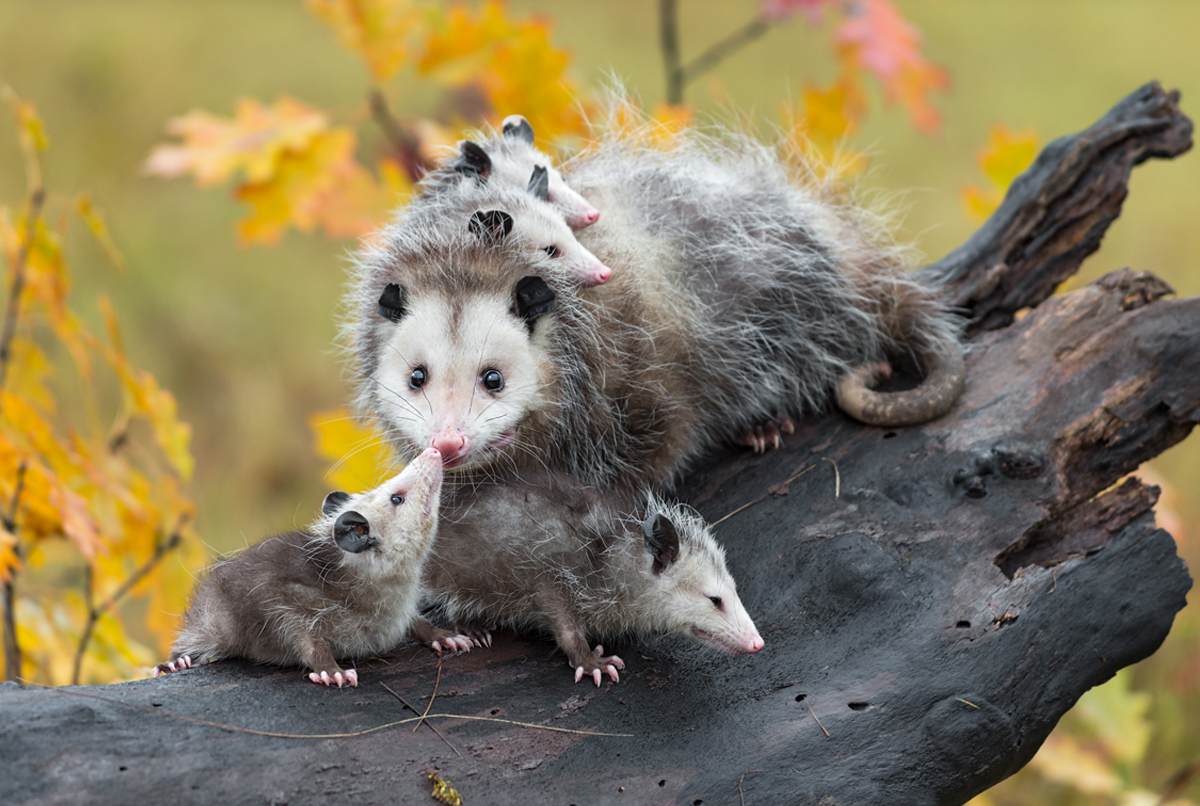6th in a six part series: Introduction, Skunks, Raccoons, Coyotes, Squirrels and Opossums
When I was a kid I had a big black and white rat for a pet. His name was Anthony. He liked to sit on my shoulder and share my popsicles. This of course made my mom mental but Anthony and I enjoyed many popsicles together and no harm done. He was a very smart and affectionate critter. Maybe that’s why I like opossums. They do look a bit like giant rats. That’s also the usual criticism they get. Looks aren’t everything.
Opossums live their quiet secluded lives very cleverly. Most of us coexist with opossums without even realizing they are around or how much they benefit nature and humans. Sometimes I wonder if people would regard opossums with care and respect if they were featured in a Disney movie. They do have a minor role in Bambi where they are depicted hanging upside down by their tails. This is a generally held myth.
Myth buster: a full grown opossum is too heavy to hang by their tail. Yet, this is such a widely held myth, one of the exhibits in the Madrona Marsh Nature Center depicts an opossum doing this very thing. Our docents have to explain that opossums use their tails for balance they can’t use it to hang upside down.
Another confusion is their name, possum vs opossum. Scientifically speaking, the possum is native to Australia. Our local backyard animal is the Virginia Opossum. The dictionary does acknowledge that both names are commonly, if incorrectly, used to describe both animals. Don’t get me started on pronunciation.
Whichever name you use there seems to be a generally held opinion that they are ugly and or scary looking. I think this is very judgmental. Once you get to know them you will find they are just another creature living their lives as best they can. Let’s get to know our local opossum!
Opossums are not rodents at all. They are marsupials; pouched mammals related to kangaroos and koalas. They are the only marsupial in North America. Marsupials give birth to live young when the baby isn’t much more than an embryo. The mother prepares a path to the pouch, and the babies use a swim-like movement to enter the pouch where they develop for 2 months.
Between two and four months of age they ride on their mothers back. From this vantage point they learn where to find food, how to avoid being food, and where to find suitable shelter during the day. Unlike other local wildlife, opossums don’t build dens to give birth and raise their young. Their breeding season is long, from February through October. Most babies are born February through June. Eleven to thirteen days after mating as many as twenty babies are born. They are so small at birth 10 could fit in a spoon! Their eyes open 55-70 days after birth. When they are too large for the pouch they climb on their mothers back. They are weaned at approximately 3 months old and are independent at 4.5 to 5 months when they are 7-9 inches long; excluding their tail.
Opossums are nature’s little sanitation engineers. If you find your garden dug up in patches, it’s not because of opossums. They have very delicate feet, good for climbing but not at all suited to digging. They eat bugs, insects, beetles, cockroaches, and fallen fruit. Their favorite foods are slugs and snails. They also eat spiders and help keep the rodent population, like mice and rats, in check. They eat the rodents the coyotes and raccoons miss.
In addition to the gourmet delicacies noted they also eat stuff I wouldn't touch with a pole. They eat dead things so rotted it’s hard to tell what it was originally. Evolution has provided them with some useful adaptations to their culinary preferences. They have a lower body temperature than other mammals and a strong immune system. Opossums very rarely contract rabies. The rabies virus can’t live in their lower body temperature. They can however, carry fleas.
Opossums, like most of our local mammals, are nocturnal. During the day they shelter for sleep in abandoned rodent burrows, attics, under brush, buildings any place offering safe shelter for a good days sleep. They don't build permanent dens. They only stay in one place for a day or two.
Are opossums dangerous to humans? That would be a hard no. Opossums are the most gentle animal out there. They don’t run or bite very well. They aren’t very well coordinated. Their primary defense is a big drama. They hiss and show a lot of small teeth. It means, GO AWAY! If that doesn't work they fall over and drop into a coma. Humans often call this ‘playing dead’. Another myth busted, this is an actual fear induced coma. Humans can be fooled, other animals not so much. Opossums biggest dangers are poison, dogs and traffic.
In any urban area opossums have a hard life. Don’t make it harder. Never leave dog or cat food outside at night because is discourages them from using the food nature provides. Never try to touch one, they don’t like humans and don’t like being touched. If you happen to see one, observe their activities.
Opossums prefer a solitary lifestyle. They don’t make good pets. There can be no sharing of popsicles with an opossum on your shoulder.
See You on the Preserve where many opossums live.
Suzan
California Naturalist
President, Friends of Madrona Marsh
Sources: Humane Society’s Urban Wildlife Program; Center for Disease Control and Prevention; Opossum Society of the United States
